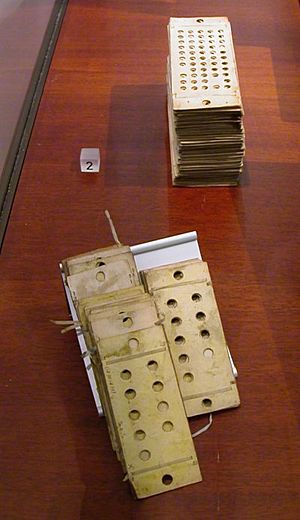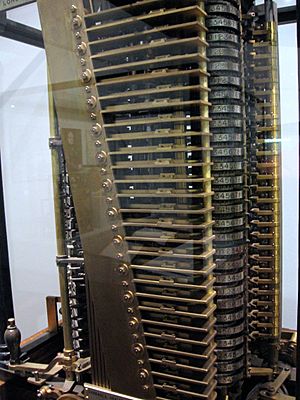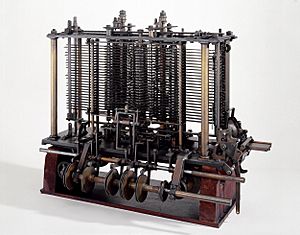Analytical Engine facts for kids
The Analytical Engine was a design for a very early mechanical computer. It was thought up by an English mathematician named Charles Babbage. He first described it in 1837. It was meant to be an improved version of his earlier machine, the difference engine, which was a simpler calculator.
The Analytical Engine was special because it included parts that modern computers have. It had an arithmetic logic unit (for calculations), control flow (meaning it could make decisions and repeat steps, like loops), and memory to store numbers. This design made it the first idea for a general-purpose computer that could do almost any calculation, a concept now called Turing-complete. This means its basic design was very similar to the computers we use today.
Sadly, Babbage could never finish building his machines. This was due to problems with his main engineer and not enough money. It wasn't until 1941 that Konrad Zuse built the first working general-purpose computer, called Z3. This was more than a hundred years after Babbage first thought of his amazing Analytical Engine in 1837.
Contents
How the Analytical Engine Was Designed

Babbage's first idea for a computing machine was the Difference Engine. This machine was designed for a special purpose: to create tables of logarithms and trigonometric functions. It did this by using a math method called finite differences. Babbage never finished building this machine either. He had disagreements with his engineer, Joseph Clement, and the British government stopped giving him money.
While working on the Difference Engine, Babbage realized he could design a much more powerful machine. This new idea became the Analytical Engine, and he started working on its design around 1833.
Input and Output Methods
The Analytical Engine would get its instructions (programs) and numbers (data) from punched cards. This was a method already used at the time to control mechanical looms, like the Jacquard loom, which wove patterns into fabric.
For showing its results, the machine would have a printer, a device to draw curves, and a bell. It could also punch numbers onto new cards so they could be used again later. The machine used regular base-10 numbers, just like we count.
The "Store" and "Mill"
The machine would have a "store," which was its memory. This store could hold 1,000 numbers, each with 40 decimal digits. That's about 16.6 kilobytes of data!
The "mill" was the arithmetic unit. This part could do all four basic math operations (add, subtract, multiply, divide). It could also compare numbers and even calculate square roots. In early designs, the store and mill were arranged in a circular way. Later designs showed a more organized grid.
Just like the central processing unit (CPU) in a modern computer, the mill had its own internal steps for more complex tasks. These steps were stored using pegs inserted into spinning drums called "barrels."
Programming the Engine
The way users would program the Analytical Engine was similar to modern assembly languages. It could handle loops (repeating actions) and conditional branching (making decisions). This meant the language was Turing-complete, as defined later by Alan Turing.
There were three types of punch cards:
- One for math operations.
- One for numbers.
- One for moving numbers between the store and the mill.
The machine had three separate readers for these different cards. Babbage created many programs for the Analytical Engine between 1837 and 1840. These programs could solve complex math problems.
In 1842, an Italian mathematician named Luigi Federico Menabrea wrote about the engine in French. This was based on talks Babbage gave in Italy. In 1843, Ada Lovelace translated this description into English and added many notes. She had been interested in the engine for years. Her notes included a detailed plan for how the machine could calculate Bernoulli numbers. This is often seen as the first complete computer program. Because of her work, Ada Lovelace is known as the first computer programmer.
Building the Analytical Engine

Later in his life, Babbage tried to build a simpler version of the machine. He managed to put together a small part of it before he passed away in 1871.
In 1878, a group called the British Association for the Advancement of Science called the Analytical Engine "a marvel of mechanical ingenuity." However, they suggested not building it. They saw its value but couldn't guess the cost. They also weren't sure if it would work correctly once built.
From 1880 to 1910, Babbage's son, Henry Prevost Babbage, worked on building a part of the mill and the printing section. In 1910, this part could calculate a list of multiples of pi, though it had some errors. This was only a small piece of the whole engine. It couldn't be programmed and had no memory. Henry Babbage's "Analytical Engine Mill" is now at the Science Museum in London.
Modern Attempts to Build It
In 1991, the London Science Museum successfully built a complete and working version of Babbage's Difference Engine No. 2. This design included improvements Babbage found while working on the Analytical Engine. The museum used materials and tools that would have been available in Babbage's time. This proved that Babbage's designs could have been built back then.
In 2010, a campaign called "Plan 28" started. Its goal was to study Babbage's original plans in detail. The idea was to create a working virtual design first. Then, they hoped to build a real physical Analytical Engine. As of 2016, building the machine hadn't started. This was because Babbage's many original drawings were hard to understand completely. By 2017, the "Plan 28" team reported that they had created a searchable database of all Babbage's materials. They also reviewed his many notebooks.
Many of Babbage's original drawings have been made digital. You can find them online for everyone to see.
How the Analytical Engine Influenced Computers
Babbage knew that having an automatic computer would make people think about how to make calculations faster. He wrote that once an Analytical Engine existed, people would ask: "By what way can these results be found by the machine in the shortest time?" This is exactly what computer scientists still study today!
Impact on Computer Science
After Charles Babbage died, his son Henry continued his father's work.
Percy Ludgate wrote about the Analytical Engine in 1914. He also published his own design for an Analytical Engine in 1908. His design was very detailed but was never built. Ludgate's engine would have been much smaller than Babbage's. It was thought it could multiply two 20-digit numbers in about six seconds.
In 1913, Leonardo Torres y Quevedo designed a Babbage-like calculating machine. It used electromechanical parts and could handle floating-point numbers. He built an early test model in 1920.
Later, in the 1930s and 1940s, when people started building electronic computers, Babbage's work was largely forgotten. This meant that many new computer builders had to figure out ideas that Babbage had already thought of. For example, Howard Aiken, who built the Harvard Mark I (an early electromechanical calculator), praised Babbage's work. However, he didn't know the details of the Analytical Engine's design while building his own machine. The Mark I did not have one of the Analytical Engine's most important features: conditional branching (the ability to make decisions). Similarly, the designers of the first electronic general-purpose computer, the ENIAC, also didn't know about the details of Babbage's Analytical Engine before they finished their design.
How It Compares to Other Early Computers
If the Analytical Engine had been built, it would have been a digital machine. It would have been programmable and Turing-complete. However, it would have been very slow. Luigi Federico Menabrea wrote that Babbage believed his engine could multiply two 20-digit numbers in three minutes.
To compare, the Harvard Mark I could do the same task in just six seconds. A modern home computer can do it in less than a billionth of a second!
| Name | When it first worked | Number system | How it worked | How it was programmed | Could it do any calculation? (Turing-complete) | Memory |
|---|---|---|---|---|---|---|
| Difference Engine | Not built until the 1990s (designed 1820s) | Decimal | Mechanical | Not programmable; numbers set by hand | No | Physical position of wheels |
| Analytical Engine | Not built (designed 1830s) | Decimal | Mechanical | Programmed by punched cards | Yes | Physical position of wheels |
| Ludgate's Analytical Engine | Not built (designed 1909) | Decimal | Mechanical | Programmed by punched cards | Yes | Physical position of rods |
| Torres y Quevedo's Analytical machine | 1920 | Decimal | Electromechanical | Not programmable; settings by cables | No | Mechanical relays |
| Zuse Z1 (Germany) | 1939 | Binary floating point | Mechanical | Not programmable; settings by cables | No | Physical position of rods |
| Bombe (Poland, UK, US) | 1939 (Polish), March 1940 (British), May 1943 (US) | Characters | Electro-mechanical | Not programmable; settings by cables | No | Physical position of rotors |
| Zuse Z2 (Germany) | 1940 | Binary floating point | Electro-mechanical (mechanical memory) | Programmed by punched film | No | Physical position of rods |
| Zuse Z3 (Germany) | May 1941 | Binary floating point | Electro-mechanical | Programmed by punched film | Yes (in theory) | Mechanical relays |
| Atanasoff–Berry Computer (US) | 1942 | Binary | Electronic | Not programmable; numbers input by cards | No | Capacitor memory |
| Colossus Mark 1 (UK) | December 1943 | Binary | Electronic | Programmed by cables and switches | No | Vacuum tubes and thyratrons |
| Harvard Mark I – IBM ASCC (US) | May 1944 | Decimal | Electro-mechanical | Programmed by punched paper tape (no decisions) | No | Mechanical relays |
| Zuse Z4 (Germany) | March 1945 (or 1948) | Binary floating point | Electro-mechanical | Programmed by punched film | Yes (by 1950) | Mechanical relays |
| ENIAC (US) | July 1946 | Decimal | Electronic | Programmed by cables and switches | Yes | Vacuum tube flip-flops |
| Manchester Baby (UK) | 1948 | Binary | Electronic | Binary program typed into memory (first electronic stored-program computer) | Yes | Williams cathode ray tube |
| EDSAC (UK) | 1949 | Binary | Electronic | Five-bit code and variable-length numbers (first stored-program computer for many users) | Yes | Mercury delay lines |
Images for kids
See also
 In Spanish: Máquina analítica para niños
In Spanish: Máquina analítica para niños



